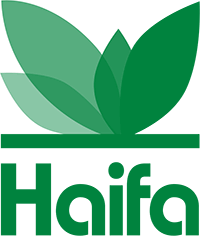Guy De Villartay [00:00:07-00:00:37]
Welcome in our new podcast, IFA Stream Greenhouses. My name is Guy De Villartay and I am an agronomist of Haifa France. This podcast is presented by Haifa Modern Greenhouses Task Force. Today, we are going to talk about foliar fertilization in greenhouses with Yishai Wachsmann from Haifa Israel. Hi Yishai, tell us about yourself and what you have chosen for this topic.
Yishai Wachsmann [00:39-00:00:52]
Hi Guy, how are you? I'm Yishai Wachsmann, agronomist of the north region of Israel. As you said, we are going to talk about the foliar nutrition in vegetables in greenhouses. We have an excellent result and I want to share it with you.
Guy De Villartay [00:00:54-00:01:03]
Okay Yishai, I think foliar fertilization is a new method of work for most farmers. So, tell me, why to use this application in greenhouse?
Yishai Wachsmann [00:01:06-00:02:12]
Foliar fertilization has a lot of benefits for the plant and in a lot of crops. In fruit plantation as an orchard and the seed use it is common practice. Also, in open field, it's become to add fertilizer to the pesticide spraying. The rationale of doing that, it's also in greenhouses culture, is reasonable. Generally, in greenhouses and particularly in soilless culture, the volume of the plant's root system is very limited. The uptake of the water and so the uptake of water and nutrients. We also need to put in mind that in high fruit load, the plant needs a high amount of nutrient, which have to transport a long distance from the roots to the leaves, fruit and flowers, in the end of the plant. Foliar fertilization pass all this long way and enter the sink origins we mentioned.
Guy De Villartay [00:02:14-00:02:19]
And so, when do you recommend doing foliar application in greenhouse?
Yishai Wachsmann [00:02:21-00:02:58]
I recommend adding the fertilizers with most of the pesticide application. I don't recommend to spray fertilizers separately, because the high cost of the labour, although there are places, labour is not an issue. The highest benefit of foliar fertilization is in cold weather, when the uptake of water and nutrient is limited by the low transpiration and heavy yield load on the plant. I also recommend when the grower want to apply specific element quickly and wants a fast response.
Guy De Villartay [00:02:60-00:003:03]
What fertilizers or formulas do you recommend for foliar application?
Yishai Wachsmann [00:03:05-00:04:13]
The farmer has to choose the right fertilizers to achieve the highest performance from the plant. As a rule of thumb, I recommend spraying the same NPK ratio or close to the one he fatigates. For example, in the initial stage, the NPK ratio is 111, so it should be the same of foliar. The second rule is to use formula based on urea, and not on ammonium nitrate or ammonium sulphate, when high nitrogen ratio is needed. The third rule is to use a single polyfeed formula and not a mix of straight fertilizers. It's much simpler and accurate, and you can apply up to 10 elements, micro and micro, in the same formula. If we talk about specific formulas, a triple 21 plus micro element is a great for initial stages, and high potassium formulas as bonus 12-2-44 are best during the fruit enlargement and harvesting.
Guy De Villartay [00:04:15-00:04:18]
How do you recommend to apply foliar fertilizer?
Yishai Wachsmann [00:04:19-00:05:14]
Generally, you want to spray the highest concentration which doesn't damage the plant. I recommend a 1% solution or 10 kg per 1,000 liter spraying solution. The spray should be at the closest and most humid part of the day, which means that in cold climate you can spray all day long, and in hot weather, it's better to spray in the early evening. Because the nutrients penetrate the leaf just when it is in a liquid phase, as long as the drop doesn't dry on the leaf, the nutrients will enter. Generally, we talk about spraying volume of 400 to 600 l per hectare, more or less. We need to know, as I said earlier, the grower will add the fertilizer to the pesticides, so we will spray according to the pesticide instructions.
Guy De Villartay [00:05:16-00:05:21]
How is the combination with the pesticide work with the plant? Can it harm the plant?
Yishai Wachsmann [00:05:22-00:06:04]
The right formula will benefit the efficiency of the pesticides. All Haifa formulas that contain phosphorus are a pH buffer between 4 to 5, which is ideal for the pesticide penetration. You might see an increase of the pesticide efficiency because of the fertilizers. Of course, you don't use fertilizers that aren't suitable for foliar application or with pesticides that you don't want them to penetrate the plant, like a copper-based bactericide. I recommend to test each combination of fertilizer and pesticides using the first time on a small number of plants before spraying the greenhouse.
Guy De Villartay [00:06:06-00:06:32]
Thanks, Yishai, for sharing knowledge with us. If I summarize our podcast, the main things in foliar spraying in greenhouse are, First, use high-quality fertilizer suitable for foliar application. Second, choose the right formula for the plant's needs. Applicate in the right dose on time and test a new combination of fertilizer and pesticides before spraying the whole greenhouse.
Yishai Wachsmann [00:06:34-00:06:36]
Thank you, it was a pleasure to be here.
Guy De Villartay [00:06:37-00:06:41]
Well, that's all for today. Subscribe for the next podcast and do not miss the next episode.
HaifaStream: When roots uptake is not enough - Foliar application
Partcipants
Guy De Villartay (Interviewer) & Yishai Wachsmann
Transcript of the episode
More Agriculture Podcasts








